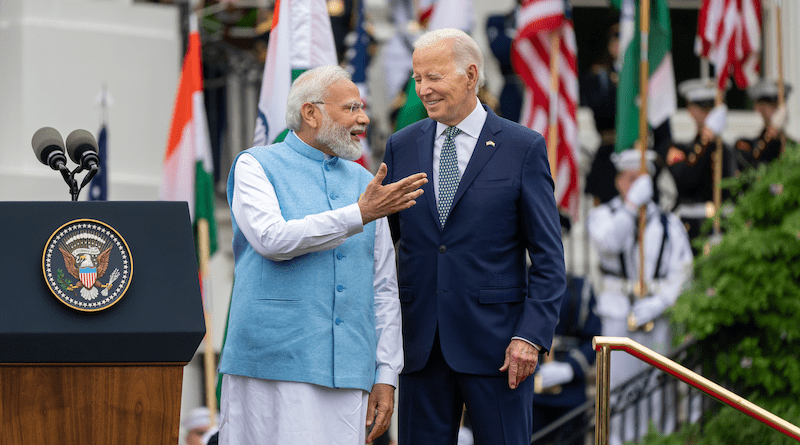Reflecting On US-India Strategic Partnership Following Modi’s Visit – OpEd
By Komal Khan
The U.S.-India joint statement issued by the White House during Prime Minister Narendra Mod’s visit to the United States outlines the high-level diplomatic engagement of India. It reflects areas of mutual interest, cooperation, and strategic goals, as well as specific commitments that entail with their interest-based strategic alignment and that both states would be bound to fulfill during their course of partnership. The United States and India have affirmed a collaborative mechanism of being among the closest partners in the world, and specifically not allies, to foster a free, open, and inclusive Indo-Pacific.
The language of the joint statement, when analyzed, matters a lot as it differs significantly from the collaborative statements released by the U.S. and its allies, Australia, ROK, and Japan, given the same objective of preserving a rule-based Indo-Pacific order in the Indo-Pacific. The US-India relationship is characterized by a strategic focus on interoperability as partners, with a primary emphasis on issue-based collaboration, as in technology, space and nuclear domains. While both countries work together to enhance capabilities and pursue common objectives, they do not have an integrated deterrence framework which the U.S. has prioritized in its strategy for its security partners in the Asia-Pacific. This distinct approach sets the U.S. policy towards India apart from its defense partners and allies in the region, as traditional alliances prioritize collective defense and integrated deterrence. Instead, the US-India partnership prioritizes issue-specific cooperation, particularly in advancing clean energy initiative to justify nuclear power plants deals, space exploration and technology sale. By capitalizing on bilateral strengths and priorities, this relationship carves out a specialized niche in the U.S. regional engagement, demonstrating a pragmatic and tailored approach to strategic cooperation.
The preamble of the statement concludes by featuring on ‘development of human enterprise’ as the focus of the partnership and the bonds of family and friends have been prioritized as their mode of carrying out the relationship. Notably, PM Modi’s delegation was composed of the Indian business community and was publicized by the Indian business advocacy group, the US-India Strategic Partnership Forum (USISPF) to the American businessmen. Together, these elements indicate a focus on the Indian economy, human resource, and the soft-power potential that can of benefit to American capitalists and as an alternate to China in the Asia-Pacific and Indian Ocean Region. Moreover, the emphasis on human rights, democracy, freedom, and rule of law indicates a commitment to creating an enabling environment for economic interests.
Interestingly, the reactors and fighter jet engines deal strategically supplements the American economy by effectively leveraging India’s economic potential to establish a lucrative market. One of the reasons behind the India-U.S. nuclear deal was that the American nuclear industry was going bankrupt. Therefore, the U.S. considered India as an emerging market for power reactors. This provided India with an NSG waiver and a de-facto recognition of India’s nuclear programme as a nuclear weapon state outside the NPT with none of the obligations of the NPT signatories. However, the co-production of advanced defense systems and India’s clean energy market would be a significant add up to the Indian economy.
The U.S. strategic approach to partner with India aims at containing China’s influence by leveraging India’s soft power, economy, and technological capabilities. The focus lies in utilizing India’s economic strength to bolster its technological advancements, positioning it as a viable alternative to China in key sectors such as telecommunications, resilient supply chains, and global digital inclusion, particularly in the context of 5G/6G technologies. This strategic initiative aims to tap into India’s soft power influence, leveraging its cultural and diplomatic assets to enhance its standing in the international arena. Similarly, India also seeks to position itself as a viable and attractive partner for global stakeholders, thereby presenting an alternative option to China. Strengthening India’s capabilities in these areas enables it to offer competitive solutions and services, potentially attracting businesses and governments seeking to diversify their partnerships and reduce dependence on China.
Likewise, the space cooperation between India and the U.S. serves two distinct purposes. Firstly, for India, it aligns with its objective of bolstering its space economy. Secondly, for the United States, it serves the purpose of establishing proximity to China, while simultaneously strengthening India’s already capable potential as a space power. The United States recognition of China’s space capabilities as a threat to the U.S and NATO underscores the strategic significance of this cooperative partnership. The timing of India signing the Artemis accords holds significance, as it presents a non-binding set of practical guidelines for space economy and lunar exploration. Herein, India stands to gain without bearing significant risks. Additionally, as space technology has historically been dual-use, the spillover effect into defense capabilities in space is expected to be substantial.
The reliability of the US-India relationship depends on India’s alignment with and service to the U.S. interests. The characteristic of South Asia as a grey zone is already a concern for the U.S., leading to a cautious approach in collaboration with India to safeguard critical technology, defense, and nuclear power interests. The limitations of the Indo-U.S. partnership are evident in defense cooperation, with a focus on technological assembling rather than transfer, to retain US control over sensitive technologies. Overall, the US-India relationship operates within a cautious framework to safeguard mutual interests in critical domains.
Hence, the joint statement signifies a significant milestone in US-India relations, emphasizing a “give-and-take” framework. The partnership aims to leverage India’s economic potential, human resources, and global diplomatic influence to benefit the US economically and strategically, given India’s proximity to China. While the statement indicates a shift towards an India-centric approach, it raises concerns about a potential arms race, and disruption in the region’s status quo, leading to increased competition at regional level. Lastly, the joint statement also reflects a complex dynamic with broader implications for South Asia by exacerbating technological disparity in the region.

